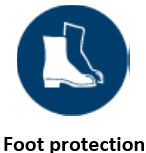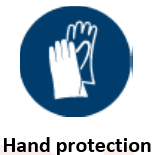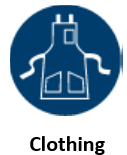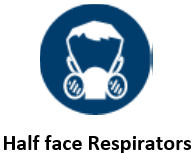Personal Protective Equipment refers to specialized clothing or equipment worn by employees for protection against health and safety hazards. Personal protective equipment is designed to protect many parts of the body, i.e., eyes, head, face, hands, feet, and ears. PPE suitable to the different classes of substances that can be worn in the event of an incident include the following:

If there is a risk of chemical splashes then safety goggles are recommended. Goggles are tight-fitting, completely covering the eyes and the area immediately surrounding the eyes. They can provide protection from impact, dust and splashes. Some goggles will fit over prescription glasses.

Face shields have transparent sheets of plastic which cover the face and protect against potential splashes or sprays of hazardous liquids and dust. They are recommended when transferring cryogens, such as liquid nitrogen or handling large quantities of liquids (> 4L). They do NOT provide adequate protection against high-impact hazards, in which case goggles or safety glasses should also be used. Throat protection may be necessary in the presence of chemical reaction set-ups which, because they are significant and/or potentially violent and/or of unknown nature, could deflagrate, detonate and send glass and chemicals flying. A blast shield is also recommended in these cases.

If work involves exposure to hot substances, corrosive or poisonous materials PPE must cover exposed body parts, including legs and feet. Shoes should completely cover the foot, enclosing the whole top of the foot. Thongs, sandals and ‘court’ shoes are not permitted in the lab. Ideally, shoes should NOT be made from a material which readily absorbs liquids (i.e. track shoes). Leather is the most widely used upper material because of its versatility, durability and resistance to chemicals. It is desirable to have dedicated lab shoes to prevent contamination in the home environment. This is particularly important if biohazardous material is handled.

Hazards to the hand may include skin absorption of harmful substances, chemical or thermal burns, bruises, abrasions, cuts, and punctures. When selecting gloves consider:
- Type of chemicals handled
- Nature of contact (total immersion, splash, etc.)
- Duration of contact
- The area requiring protection (hand only, forearm, arm)
- Grip requirements (dry, wet, oily
- Thermal protection
- Size and comfort
- Abrasion/puncture resistance requirements
Before use, inspect gloves to ensure they are not torn, cut or punctured. A more thorough check can be made by filling the gloves with water and tightly rolling the cuff towards the fingers will help reveal any pinhole leaks. Gloves that are discoloured or stiff may also indicate excessive use or degradation from chemicals. Discard damaged gloves. Disposable gloves should be changed often and not reused. Any gloves from which hazardous chemical contamination cannot be removed must be collected as contaminated waste. Gloves contaminated with biohazardous material should be handled as biohazardous waste.

Long-sleeved, fully buttoned-up coats or wrap-around gowns, which are easy to remove, must be used in all cleaning work that involves hazardous material. Coats help prevent the contamination of regular clothes from splashes and toxic material.
To reduce the risk of contamination coats should be removed on leaving the incident area. A coat which is grossly contaminated with hazardous material must be disposed of as hazardous waste.

Half-face respirators can be used to protect against a variety of particulates, gases and vapours depending upon the cartridges chosen. Cartridges contain filters. These filters rely on sorbent material to “soak up” the gas and vapour molecules. Typically the sorbent is carbon which has been specially treated. Depending on the chemical treatment of the carbon surface, this material will absorb different types of gases or vapours.